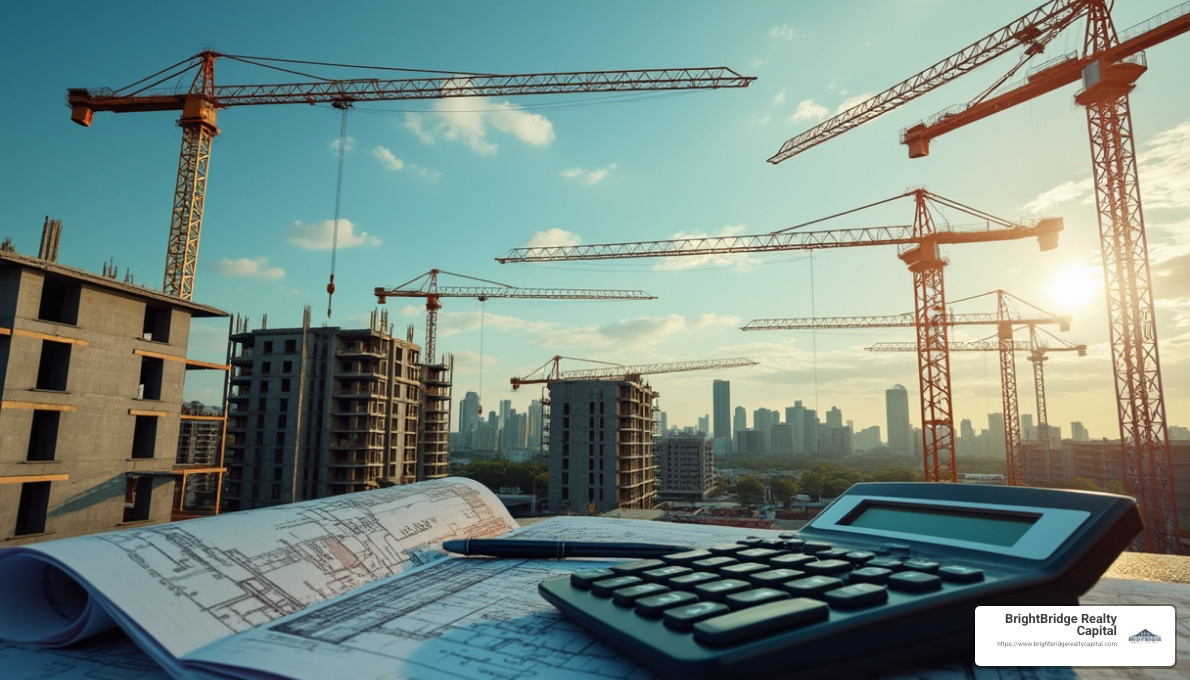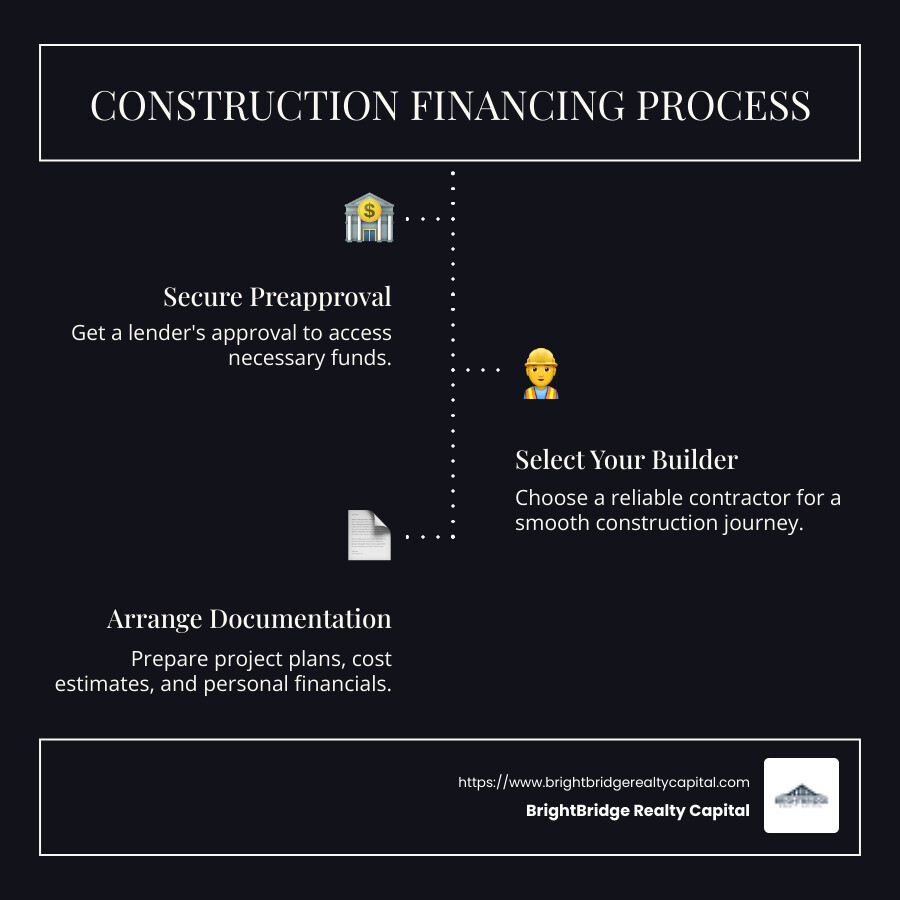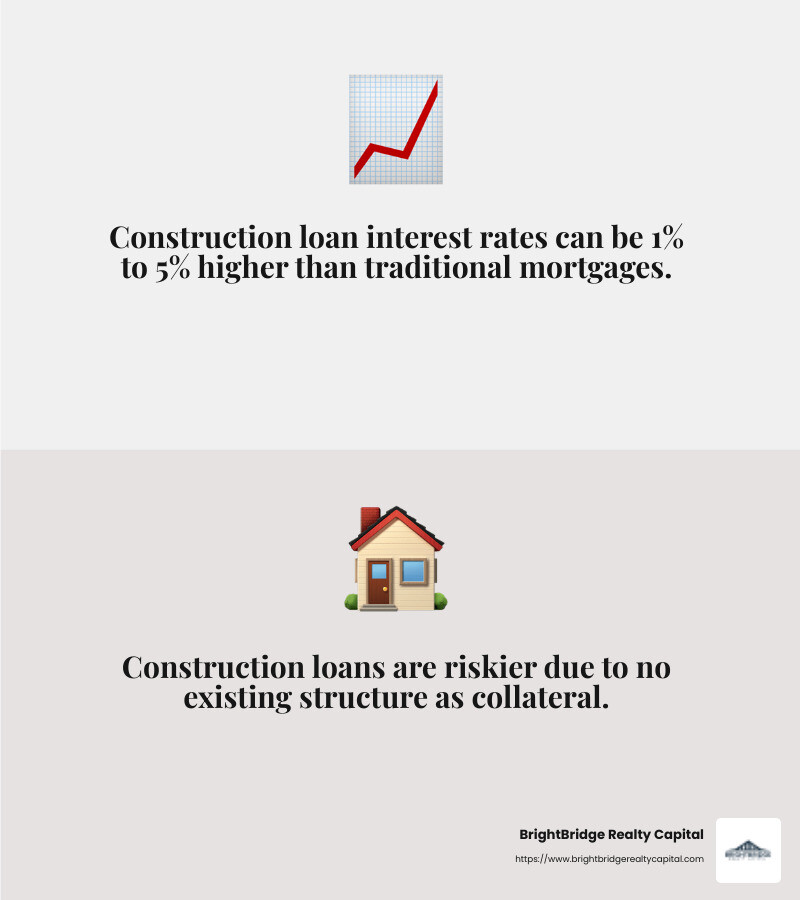From Blueprint to Reality: Mastering the Construction Financing Process

Construction financing process is the roadmap to bringing your real estate vision to life. Whether you're building a new home, expanding a rental portfolio, or starting on a fix-and-flip trip, understanding this process is vital. Here's a quick overview to get you started:
- Secure Preapproval: Begin by getting a lender's nod to access the funds you need.
- Select Your Builder: Choose a qualified and reliable contractor to ensure a smooth construction journey.
- Arrange Documentation: Prepare detailed project plans, cost estimates, and personal financials.
- Close the Loan: Finalize the loan details and get ready for construction.
In the busy world of real estate, construction loans are your trusted partner in turning blueprints into bricks and mortar. They provide the critical funds needed to transform vacant lots into vibrant, income-generating properties. These loans are a little different from traditional mortgages—they're short-term, have higher interest rates, and operate on a draw schedule with funds released in phases.
It's exciting but can also be daunting. However, with BrightBridge Realty Capital by your side, you have the tools to steer the construction financing process smoothly. Our flexible, stress-free financing solutions streamline the journey from blueprint to reality, offering a seamless transition from construction phase to permanent financing.
Explore the opportunities and pave the way for your next investment success story!

Key Construction financing process vocabulary:
Understanding the Construction Financing Process
Types of Construction Loans
Navigating the construction financing process starts with understanding the different types of construction loans available. Each loan type is custom to specific project needs and borrower situations.
Construction-Only Loan: This is a short-term loan that covers only the construction phase. Borrowers make interest-only payments during the build and must pay off the loan or refinance once construction is complete. It's ideal for those who plan to shop for a permanent mortgage later.
Construction-to-Permanent Loan: This option starts as a construction loan and automatically converts to a permanent mortgage once the construction is finished. It simplifies the process by eliminating the need for separate closings, making it a popular choice for many.
Renovation Loan: Designed for those looking to remodel or renovate existing properties. This loan can be a great option for improving and increasing the value of a property.
Owner-Builder Loan: Suitable for those who act as their own general contractor. This can be a cost-effective route if you have the expertise and time to manage the construction.
End Loan: This is a traditional mortgage that kicks in after the construction is complete, often used to pay off construction-only loans.
Land Loan: Used to purchase land where you plan to build. Typically, these loans have higher interest rates and require a substantial down payment.
Key Steps in the Construction Financing Process
Once you understand the types of loans available, the next step is to steer the key stages of the construction financing process:
Preapproval:
- Eligibility: Start by ensuring you meet the lender's criteria. This often includes a solid credit score, a detailed construction plan, and proof of financial stability.
- Documentation: Gather necessary documents like financial statements, project plans, and builder contracts. This helps streamline the approval process.
Builder Selection:
- Choose a reputable builder with a proven track record. A good builder can increase lender confidence and ensure your project stays on time and budget.
Paperwork:
- Once you have preapproval, work with your lender to finalize the paperwork. This includes signing loan agreements and setting up a draw schedule for fund disbursement.
Closing:
- This is the final step before construction begins. You'll finalize all loan terms and sign the necessary documents. Once closed, the construction funds are ready to be drawn as needed.
With these steps, you're well on your way to turning your construction dreams into reality. Each step is crucial in securing the right financing and ensuring a smooth construction process.
Construction Financing Process: From Start to Finish
Phase 1: Securing a Construction Loan
The first step in the construction financing process is securing a construction loan. This involves several key steps:
Eligibility and Preapproval: Start by ensuring you meet the lender's requirements. A solid credit score, detailed construction plans, and proof of financial stability are crucial. Preapproval helps you understand how much you can borrow and sets a clear path for your project.
Documentation: Gather necessary documents such as financial statements, a complete construction plan, and builder contracts. These documents are essential for the lender to assess the viability of your project.
Loan Approval: Once your documents are in order, the lender will review your application. Approval generally depends on your creditworthiness, project details, and builder credentials.
Phase 2: Managing the Construction Phase
Once your loan is approved, the focus shifts to the construction phase:
Draw Schedule: Funds are disbursed in stages, known as draws, which align with project milestones. This ensures that the money is used effectively as construction progresses.
Inspections: Lenders often require inspections at each stage before releasing funds. This ensures that the project is on track and meets quality standards.
Interest-Only Payments: During construction, you'll typically make interest-only payments on the funds that have been disbursed. This keeps your payments lower while the project is ongoing.
Phase 3: Transitioning to Permanent Financing
After construction is complete, it's time to transition to permanent financing:
Conversion or Refinancing: If you have a construction-to-permanent loan, it automatically converts into a traditional mortgage, simplifying the process. Otherwise, you'll need to refinance the construction loan into a permanent mortgage.
Closing Costs: Be prepared for closing costs associated with the conversion or refinancing. These costs can include fees for appraisals, title insurance, and document preparation.
By understanding each phase of the construction financing process, you can steer the journey from blueprint to reality with confidence. Keep the lines of communication open with your lender to ensure a smooth transition through each stage.
Common Challenges and Solutions in Construction Financing
Navigating the construction financing process is not without its problems. However, understanding the challenges and implementing effective solutions can significantly ease the journey.
Mitigating Financial Risks
Construction loans often come with higher interest rates compared to traditional mortgages. This is due to the increased risk lenders take on, given that the collateral (the building) is not yet complete. These rates can be 1% to 2% higher than regular mortgage rates.
Cost overruns are another common issue. Unforeseen expenses, such as finding poor soil conditions, can quickly inflate your budget. To mitigate these risks:
Budgeting: Create a detailed budget that includes all potential costs. Be realistic and thorough in your estimations.
Contingency Funds: Set aside contingency funds, typically 10% to 15% of the total project cost, to cover unexpected expenses.
Lender Communication: Maintain open lines of communication with your lender. Inform them promptly of any changes or delays to avoid misunderstandings and potential funding issues.
Navigating Approval Complexities
The approval process for construction loans is more complex than that for traditional mortgages. Lenders require detailed plans, proof of financial stability, and often prefer working with experienced builders.
To steer these complexities:
Detailed Plans: Submit comprehensive construction plans, including blueprints, timelines, and budgets. This helps demonstrate the viability of your project to the lender.
Experienced Builders: Choose a reputable builder with a track record of completing similar projects on time and within budget. Lenders are more likely to approve loans for projects led by experienced professionals.
Credit Score: A strong credit score is crucial. Most lenders require a minimum score of 680, with some demanding 700 or above. Regularly check your credit report and address any issues before applying for a loan.
By understanding these challenges and implementing strategic solutions, you can improve your chances of securing and successfully managing a construction loan. This proactive approach not only mitigates risks but also ensures a smoother path from blueprint to reality.
Frequently Asked Questions about Construction Financing Process
What is the difference between a construction loan and a traditional mortgage?
A construction loan is a short-term loan used to finance the building of a new home or major renovations. Unlike a traditional mortgage, which provides a lump sum to purchase an existing home, construction loans are disbursed in stages. These installments align with key phases of the construction process, such as foundation completion or roof installation.
Traditional mortgages typically have lower interest rates because they are less risky; the home itself serves as collateral. In contrast, construction loans carry higher rates due to the risk that the project may not be completed as planned.
How do interest rates for construction loans compare to regular mortgages?
Interest rates for construction loans are generally higher than those for regular mortgages. This is because construction loans are considered riskier; there is no existing structure to secure the loan. Rates can be 1% to 5% more than standard mortgage rates.

If you choose a stand-alone construction loan, be aware that fluctuating interest rates during the building phase can lead to higher installments. However, some construction-to-permanent loans allow you to lock in a rate, offering some protection against rising rates.
What are the typical requirements for securing a construction loan?
Securing a construction loan involves several requirements beyond those of a traditional mortgage. Here are the key elements lenders typically look for:
Down Payment: Most lenders require a down payment of at least 20%, although some may ask for up to 30%.
Creditworthiness: A strong credit score, often 680 or higher, is crucial. Lenders want assurance that you can manage the loan.
Detailed Construction Plans: You'll need to provide comprehensive plans, including timelines, budgets, and architectural drawings. This demonstrates the project's feasibility.
Builder Credentials: Lenders prefer working with experienced and licensed builders. They may require financial statements and proof of insurance from your contractor.
Liquidity: Some lenders want to see that you have additional cash reserves to cover potential cost overruns.
By understanding these requirements, you can better prepare for the construction loan application process and increase your chances of approval.
Conclusion
Navigating the construction financing process can be complex, but it doesn't have to be daunting. At BrightBridge Realty Capital, we specialize in making this journey as smooth and efficient as possible. Our expertise in real estate financing allows us to offer custom solutions that meet your unique needs, whether you're building from scratch or undertaking major renovations.
One of the standout features of our service is the seamless process we provide. From your initial application to the final payoff, our team is dedicated to managing every detail in-house. This means you can focus on your project while we handle the complexities of financing. Our direct lending approach eliminates intermediaries, allowing us to offer competitive rates that are hard to beat.
We understand the urgency of real estate projects, which is why we pride ourselves on our fast closing times. Often, we can close deals within a week, ensuring that you have the funding you need when you need it. This quick turnaround can be crucial in taking advantage of timely opportunities in the real estate market.
If you're ready to turn your blueprint into reality, we're here to help you every step of the way. Our customized financing solutions are designed to keep your project on track and your investment strategy moving forward. Trust BrightBridge Realty Capital to bridge the gap between your vision and its realization.


